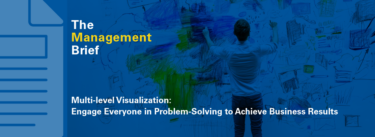How many emails do you have in your inbox? How much time out of your day do you spend trying to catch up on email? In today’s world, personal and business correspondence has drifted sharply away from in-person conversation and even voice communication.
Email, social media, and texting have valuable benefits when used in moderation. But, think about it… Have you ever emailed a response to a question from someone who works on the same floor as you? When it became clear to you that they didn’t quite grasp what you were saying, how often have you dropped into old habits and hit reply, trying the same method of communication that didn’t work the first time? How well did that turn out?
We talk a lot about Lean. I’ve been thinking a lot about what lean communication means. If you want to be lean in your communication, it’s important to make sure your message and means of communication are as error-proof as possible. It’s important to make sure your message actually gets received in the manner by which you wish to convey it.
Too often during the PDCA cycle change management efforts get botched due to insufficient communication. I’ve coached managers who sincerely feel an email notice to their staff is enough to engage them in a process change! These same managers wonder why each team member has a different understanding of the message they’ve been given. No wonder no one is following the new process, let alone working together to solve problems and continue to improve the current state.
If you did a Value Stream Map on the cycle time of a discussion email stream verses a 1:1 conversation in person or over the phone, you’d find it takes much longer via email if you include wait time between send and reply. Plus, it’s worth looking at how many times it’s necessary to clarify a point, and the length of time it takes to proofread emails. Stevie Ray discusses all of this in The Business Journals.
Put simply: email, text, etc. – these aren’t necessarily the best methods for conversation because you’re missing two key elements of human communication: body language and tone of voice. When these two things are missing, interpretation of your message is up to the perception of the recipient. It’s based on how they are feeling that day and whether or not you used words that synced with their mental point of reference. (Read more from Anthony Tjan in the Harvard Business Review on the increase of emails and decline of 1:1 communication).
The point is, if we can improve our information through-put, then we will suffer less from confusion and misdirection as well as excessive time spent following up and clarifying.
So, next time you want to get others involved in your change initiative, what should you do? Have an open dialogue on whatever you want to discuss and try to abide by the following rules:
#1: Be Brief. It’s fine to chat about your weekend plans if it’s just a two-person conversation. However, in a group setting, or when time is of the essence, keep it brief. Otherwise you are disrespecting people’s time.
#2: Be Open. The purpose for having this dialogue should not just be to talk about your point of view. Set aside your opinions long enough to consider what others have to say objectively and be open to changing your mind.
#3: Actively Listen. Allow others to speak freely without getting too far off topic or taking a detour on Pity Parkway either (no one wants to listen to a complaint session). Agree to stay on topic before you begin. Listen to what your team member has to say without thinking about what YOU are going to say next. Just listen.
Rule #4: Ask Why. Ask reflective questions to better understand the message or topic at hand. If you’re dealing with a problem– asking why will help you discover the root cause in lieu of simply jumping to the first easy solution.
Rule #5: Ask for Opinions! Don’t hesitate to poll your team members for thoughts! This encourages open dialogue and loosens the tongues of people who naturally stay quiet.
Rule #6: Paraphrase. As a manager or change agent, it’s ok to repeat what you thought you heard from your team members back to the group. It’s actually smart. You are simply making sure that the entire group has a consistent understanding of what has been decided or conveyed.
Rule #7: Determine Action Items. Before the session ends, ascertain actions that need to be followed up on, ensure someone is responsible for each item, and set a due date.
If you can do these things, you have a good shot at being the change agent who experiences a high sustainability rate with your continuous improvements. The manager who everyone knows is engaged with their employees and a champion of positive change. You’ll be able to hold people accountable without it feeling like a chore and you’ll save yourself time be refusing to sling ideas across internet-space. If you make a point to start meaningful conversations regularly, people will feel that you’re interested in their work and they’ll start coming to you, initiating more improvements themselves.
Funny how just talking can make all the difference. Unfortunately, we human beings make things complicated. And as a society, we don’t pause to breathe often enough and really think about our actions, all too quickly believing the myth that electronic = faster.
Sometimes being old school about communication is cool, and it’s definitely more lean.





